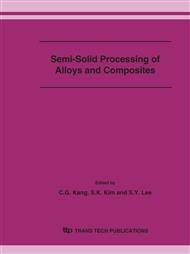p.626
p.630
p.635
p.639
p.643
p.648
p.652
p.656
p.661
Microstructure and Stress Variation of Semi-Solid Magnesium Alloy during Isothermal Compression and Its Relationship to Thixotropy
Abstract:
Thixotropy is the most important characteristic of semi-solid materials, and it is decided by the variation of microstructure during action of handling. In this paper, for the sake of the industrial thixoforming and numerical simulation, microstructure and stress variation of semisolid magnesium alloys during isothermal compression is researched. Here, samples are heated to the desired temperature in the empty space with various holding times and compressed horizontally. Stress–strain curves during compression can be given directly by the experimental computer, and each of curves show a peak stress in a small strain and then decrease rapidly, which originally because of the thixotropy of semisolid materials. Moreover, thixotropy of semisolid magnesium alloys is clearer with the evolution of microstructures including agglomeration and deagglomeration of solid particles and the moving way of liquid at different places and strain under different conditions. Microstructures during isothermal compression show that the deagglomeration of solid particles increase with increasing the strain rate, therefore, the thixotropy of semisolid magnesium alloys increases. However, when solid volume fractions are lower, the agglomeration of solid particles doesn’t change obviously with increase or decrease factors, meaning that the thixotropy is smaller. Relationships between thixotropy and microstructure at other different conditions are also given according to the experiments and analysis.
Info:
Periodical:
Pages:
643-647
Citation:
Online since:
October 2006
Authors:
Keywords:
Price:
Сopyright:
© 2006 Trans Tech Publications Ltd. All Rights Reserved
Share:
Citation:


